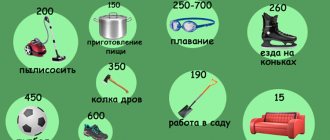How was the research conducted?
The study by Harvard scientists involved volunteers who spent three weeks indoors without windows or natural light. Since all watches and devices were confiscated, participants did not know what time of day it was. They could only rely on their feelings.
Each subsequent day they went to bed four hours later. Experts monitored how many calories were burned in the participants' bodies at rest at different times of the day and night. Since the time of going to bed and waking up changed every day, the scientists were able to track the schedule of energy expenditure.
Photo: istockphoto.com
How many calories are spent in 1 hour of fitness?
As we have already said, calorie expenditure depends primarily on your weight, as well as on the physical activity itself.
Aerobic exercise and step aerobics require large amounts of energy . These are high-intensity workouts with complex, coordinated exercises. How many calories are spent in 1 hour of such a load also depends on the complexity of the workout.
So, a person weighing 60 kg will burn about 300 calories during a moderate workout , while an intense workout will burn 420 calories per hour! Step aerobics has even higher results of such training. Water aerobics also burns calories well; in one hour of such training you will burn about 300 calories.
Circuit training can also boast of such high performance.
In 1 hour of circuit training you can lose about 350-400 calories. In addition, such a load perfectly develops endurance.
If you have any elliptical trainer at home, do not let it sit idle. How many calories you burn in 1 hour on the elliptical trainer depends on your weight. At 55 kg you will burn about 500 calories, at 70 kg this figure will increase to 650 calories per hour, and at 83 kg it will be 800 calories !
Another exercise machine that can help you burn calories is an exercise bike . In 1 hour of very active exercise you can burn up to 700-800 calories. If the load is average, then you will spend from 400 to 600 calories, which is also an excellent result.
How many calories you burn in 1 hour of strength training will depend on how intensely you exercise. But on average, such a load will burn about 400 calories. And don't forget that after strength training, your body will continue to burn calories long after you've finished.
Fans of quiet exercise - stretching, yoga, callanetics - burn about 250-300 calories in one hour of activity. But dynamic yoga (Ashtanga yoga) will burn approximately 420 calories in 1 hour.
How many calories you burn in 1 hour of swimming depends on the swimming style you choose. So crawl swimming burns about 400-600 calories per hour , and breaststroke about 300. Remember that the faster you swim, the more calories you will burn.
What are the results?
The experiment showed that in the morning the body was less active than in the evening, while in the afternoon the body at rest burned 10% more calories than at midnight.
Scientific approach: 5 ideal express breakfasts
A person burns about 130 calories without extra effort in the middle of the day. And, despite the general belief that you can afford everything delicious for breakfast, it is better to eat a cake or drink a cup of cappuccino with syrup at lunch. According to study co-author Jean Maffey, this is when the body is more efficient at converting calories into energy.
Photo: istockphoto.com
How many calories do you need to burn to lose weight?
To burn 1 kg of fat you need to spend an average of 7000 kilocalories (plus/minus 500 kilocalories). They also recommend losing weight gradually and smoothly, namely by 4 kg per month maximum. To burn 500 g of fat per week, you will need to burn about 3,500 kilocalories, 550 kilocalories per day. And such a deficit only needs to be done in order to get rid of 2 kg in a month.
If you follow a diet that allows you to create a deficit of 500 kilocalories per day, you will be able to lose 1 kg in 2 weeks . That is why doctors emphasize the need to use not only a balanced diet, but also physical activity. You also need to take into account that the lower your body weight becomes, the greater the calorie deficit is needed, which makes it necessary to recalculate the amount of calories consumed every 2-4 weeks.
You can lose 1 kg of body weight only by creating a deficit of 7000 Kcal, but this rule only works in the first 1-2 weeks of active weight loss, because subsequently metabolic processes slow down greatly. For subsequent weight loss, you will need to increase your calorie deficit.
What does this depend on?
Scientists have decided that it's all about the circadian rhythms that control our biological clock. The participants were not guided by time; the body worked exclusively according to these very internal circadian rhythms. Each of them wore a special sensor, which measured important vital signs, including body temperature. This allowed scientists to determine energy consumption. More calories are burned when the temperature rises.
Morning, evening or night: when is it most effective to exercise?
Myths and truths about nutrition: should you count calories to lose weight?
Appetizing forms: how many calories are in popular fast food?
How to burn your daily calorie intake
Home — For the public
- Map of medical organizations
- Vaccination
- Clinical examination
- Fluorography
- Addresses and opening hours of clinics
- Emergency rooms
- Oncology
- Where to take an HIV test
- Healthy child's office
- Services
- Prevention of CVD
- Disease Prevention
- World Patient Safety Day
- Newspaper "Medical News"
- specialist
- School of Health
— Disease prevention
- HIV infection
- All about vaccination
- All about proper nutrition
- Hepatitis
- Flu
- Dementia
- Schoolchildren's health
- STD
- Tick-borne encephalitis
- Whooping cough
- Measles
- Legionellosis
- Meningococcal infection
- Oncology
- Acute intestinal infection
- Pediculosis
- First aid
- Pneumococcal infection
- Pneumonia
- Prevention of rabies
- Dependency Prevention
- Rotavirus infection
- Diabetes
- Cardiovascular diseases
- Injuries
- Tuberculosis
- Tularemia
- Physical activity
- Obstructive pulmonary disease
- Exotic infections
- Ecology
- Why is swimming in ponds dangerous?
— Physical activity - a healthy future — How you can burn your daily calorie intake
In order to keep the body in good shape, you need to burn 150 kcal per day. How to understand how many calories we have already burned? How long does it take to burn exactly 150 calories? These questions arise immediately after reading the previous sentences. There are many recommendations and visual tables that indicate the type of physical activity and how much time is spent on each of them to burn a certain number of calories.
Often we can stumble upon types of physical activity that we can only encounter a couple of times a year, for example, swimming for 20 minutes (realistically, if we managed to swim at least once this summer or forced ourselves to sign up for a pool), quickly ride a bicycle (realistic if you use this type of transport every day and are late for work. In my case, this is generally unrealistic, since I don’t own two-wheeled vehicles at all) or climb a mountain (apparently, for climbers).
Here we have selected those types of physical activity that are more daily and everyday in nature.
To lose 150 kcal, you can:
- 60 minutes to wash windows or floors (for active housewives);
- 30 minutes walk (in general, for everyone who needs to get around at least to work or to the store);
- 15 minutes to climb the stairs (for those whose elevator is broken. The same option, only with the word “go down”, I think, is also being considered);
- Wash the car for 45-60 minutes (for car enthusiasts who are economical and who trust washing their “swallow” only to themselves);
- Weed the beds for 30-45 minutes (this, of course, is for all summer residents);
- Rake fallen leaves for 30 minutes (wait a little longer when autumn is in full swing);
- 15 minutes to remove snow with a shovel (after you have removed the leaves, wait a little longer).
If you are interested in physical activity related to sports, then you can:
- 30 minutes of Nordic walking;
- 45 minutes of playing volleyball;
- Ride a bike for 30 minutes (ride 8 km);
- 30 minutes of dancing (fast dancing);
- 20 minutes swim;
- play basketball for 20 minutes;
- 15 minutes run (1.5-2 km);
- 30 minutes of gymnastics in the water;
- Jump rope for 15 minutes.
Remember that to determine the most correct and beneficial load for you, you need to consult with a physical therapy doctor or a trainer in the gym.
Be healthy!
Text: Anastasia Koneva.
The article uses data from the State Research Center for Preventive Medicine of the Ministry of Health of the Russian Federation
Does this affect training time?
Since the study focused on calorie burning at rest, it's not entirely clear whether there would be any benefit from exercising during this time. So you don’t have to rush to move classes to the middle of the day.
In addition, not many people took part in the experiment - 7 people, so the results can still be called only preliminary.
Photo: istockphoto.com
How many calories do you burn during sex?
Sex is, of course, not a full-fledged workout, but it provides powerful physical stress to the body, and this can be used for weight loss . Here's what experts say about this method of burning calories:
- One kiss destroys 68 kcal, but only if it lasts 60 minutes. If a woman kisses her beloved man in a position on top and simultaneously performs push-ups, then she will be able to get rid of 70 kcal in 10 minutes.
- Undressing each other burns about 8 kcal. If a man begins to unfasten his beloved’s bra with his teeth, he will burn about 50 kcal in 1-3 minutes!
- The massage will be pleasant for both partners. In an hour of such pleasure you can burn 80 kcal. Both the massage therapist and the person receiving the “service” will have the same result.
- 30 minutes of slow, erotic dance, even in clothes, and you can get rid of 100 kcal. The pace may vary, but it is better if it starts to gradually accelerate.
- An hour of active sex - and 145 kcal will be burned. If the woman is in the position on top, then you can safely add another 50 kcal to this indicator.
If you count all of the above, then in half an hour of full-fledged sex with foreplay and “games” you can lose almost 400 kcal . This is equivalent to 100 g of chocolates and 50 g of sweet paste.
You can burn calories in various ways. The most pleasant thing is sex with your loved one, but it will not give impressive results. Therefore, it is better to combine “carnal pleasures” with banal physical activity and lose weight smoothly, while maintaining muscle mass.
For whom is this important?
The study's findings particularly impact people with shift and night work schedules. This is no less important for night owls who are used to staying awake at night. Disturbances in circadian rhythms primarily affect health. This can lead to consequences such as diabetes, obesity, and cancer.
Interestingly, the time of expenditure of the greatest amount of energy varies individually (from 12 o'clock to 18 o'clock in the evening). Scientists have determined that despite the general time indicators of the study, it is important to adapt to your internal biorhythms, and the body will focus exclusively on them.
What are calories?
Calories are energy obtained from food and drinks. The body needs calories from food throughout the day: it burns them during sleep, while eating, working and, of course, physical activity.
The main sources of energy for the body are represented by 3 main macroelements: carbohydrates, fats, proteins. The calories obtained from them are either used as physical energy or stored as fat.
You can get rid of calories stored in fat reserves in one of 3 ways:
- Reducing calorie intake, as a result of which the body begins to draw energy from reserves.
- Increased physical activity compared to normal.
- A combination of both steps.











